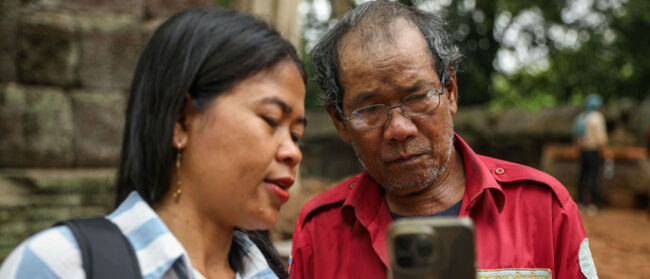The Cambodia Urban Art Festival will be kicking off in Phnom Penh on Friday with a weekend of jam-packed events – most of which are free – and will showcase the talents of graffiti artists from both near and far away.
During the day, artists will be tasked with taking to the streets to paint on-the-spot murals across the capital, and then at night you can unwind by catching a free concert or live painting performance.
Organisers of this year’s festival say that they hope this weekend’s festival will help to build the city’s excitement for local art and eventually lead to the capital establishing itself as a hub for regional street art.
“We are aiming to push and develop the art scene in Cambodia,” says Chifumi, who is both the founder and curator of the Cambodia Urban Art Festival. This year will mark the third round of the successful street festival, with this year’s iteration being achieved through the help of co-organisers Théo Vallier and Laetitia Trousse.
You can see some of Chifumi’s own art on display at this weekend’s festival, plus a number of up-and-coming or already established artists from around the world. There’s a lot to choose from though, so the Southeast Asia Globe has picked through some of the artists you’d be amiss to skip out on at this year’s edition.
Chifumi
You can most easily recognise the work of Chifumi for its pop art influences that are often mixed with traditional Khmer patterns.
Some of his more popular pieces feature big paintings of hands dancing on walls, but this style has undergone an interesting transformation since he made the move from France to Cambodia.
When he first came to Phnom Penh, Chifumi began to experiment by using the different poses that Cambodian Aspara dancers make with their hands as a model for his art. Prior to this, he had been using an albeit less conventional source of inspiration for his hand-focused paintings; that is, the hand gestures that gangs make to signal their loyalty to various crews.
He is now based out of Cambodia, but when he travels to create murals around the world he says his style still reflects a combination of contemporary illustration with the decorative style of Khmer architecture.
When asked about what he hopes the fruits of his labour will bear after this weekend’s festival wraps up, Chifumi said the answer is simple.
“One of the main aims of this event is to support local people and up-and-coming artists by providing a platform where they can show off their art.”
Theo Vallier
One of the very first street artists to emerge from the Cambodian urban art scene, Theo says that he gets most of his inspiration from Khmer mythology. He has also come to be known for his experimental style, which in the past has included testing materials like paint on rusty metal surfaces.
As one of the co-organisers of the festival, Theo says that he hopes the mentorship that the festival provides for young Khmer artists will help bring about a new artistic and cultural appreciation in the city.
“In the long run, within five years or so we would love to see art events in Phnom Penh continue to grow and flourish in the hope that the city may grow into a regional art hub,” he says.
Theo has had his work on display at exhibitions in both France and Cambodia.
Davido
Rising Cambodian artist Davido says his art is influenced heavily by cubism and that he tries to highlight the individual characteristics of animals through his surrealist artwork.
One example of his contemporary and animal-inspired art style was on display last year at an exhibition in France, where Davido unveiled a giant mural of a forrest that showed a tiger becoming intertwined in a lotus flower.
“My style is constantly evolving and I find myself now moving away from the geometric forms of art that I started off with and turning toward placing emphasis on depicting animals in my work,” he said. “I try to highlight the intricate characteristics of the animals because I feel as if they are something that we can all relate to and see in ourselves.”
Ket Monnyreak
Monnyreak, originally a graphic designer, is in the creative process of learning about new art forms and expanding his artistic boundaries.
“I love drawing lettering more than any other style. I normally do custom type drawing in both Khmer and English language. It’s really hard for me and still something I’m learning and trying to improve every day,” he said.
Monnyreak is humble as he routinely questions whether or not he should even be thought of as an artist. He admits that his evolution from creating intricate graphic designs to capturing the urban landscapes of Phnom Penh is not something he ever saw himself doing.
“I never wanted to become an artist. I never thought I could make a living out of it,” he said. “Now I realise that’s all I want to do, love to do and never get tired of doing. Maybe that makes me an artist. Probably.”
Kakada Yi
Kakada is a young Cambodian artist just breaking out on the urban street art scene. His work draws heavily on traditional Khmer themes and blends them with the harsh confrontations of urban reality.
Being raised as an orphan, Kakada explains how a lot of the struggles that he faced growing up have influenced his art and continue to be a constant source for inspiration.
“I felt like I had nothing [growing up] except for my art. I tried to create art so I could feel as if I belonged somewhere,” he said.
“The circumstances that set me on this road made me the artist I am today. The experiences I have had allow me to show through my art that life is about hope. I hope my art will amaze people and leave them smiling and thinking about life itself.”
FONKI
Starting out as a prominent member of Montreal’s new generation of graffiti artists, FONKI, a Cambodian-Canadian artist, moved to Phnom Penh with the aim of reforming the Cambodian urban art scene through the act of sharing his artistic vision.
In time, he has gained recognition as one of the innovators of Kbach graffiti lettering, an urban art form that fuses both modern and traditional Cambodian art. His style has also come to be synonymous with the giant portraits he canvasses across city walls, which often depict the everyday life of local Cambodians.
FONKI’s return to his ancestral Cambodia and his initial goal of imparting a love for street art within the nation’s youth was the topic of a 2012 documentary called ‘The Roots Remain’. The film documents how FONKI used street art to help revitalise the art scene of the once fractured country and follows his journey to create a tribute for the relatives his family lost during the Khmer Rouge.
His art can be found on the streets of France, Cambodia, Belgium, England, Mexico, Vietnam, and the US.
You can check out all of these artists, and many more, at this weekend’s Cambodia Urban Art Festival from Friday, 7 December to Sunday, 10 December. To find out more visit the Cambodia Urban Art Festival Facebook page.


